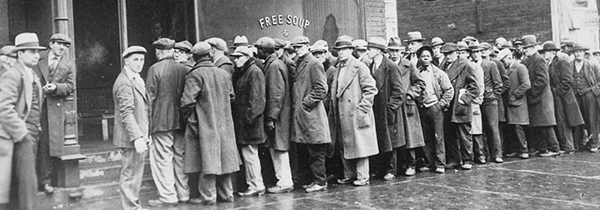How to Market During a Downturn – Part 1: Take Advantage of Quiet Competitors
If your business has been affected by the COVID-19 (coronavirus) pandemic, then you might think it’s a good time to scale-back your marketing budget and focus on riding out the storm.
We’re here to tell you why you SHOULD NOT cut back on marketing, and instead take advantage of the fact that your competitors are making the mistake of cutting their own budgets.

Why you should increase your marketing spend during a downturn:
In the past, when there has been a period of economic downturn (like the Great Depression, and more recently, the Great Recession), brands have cut back their marketing budgets in response to the drop in consumer confidence.
While this may seem like a common-sense move, there is plenty of evidence to show that you should increase your marketing budget during a period of economic downturn:
- During the Great Depression the cereal brand Kellogg’s, instead of decreasing their advertising budget like their main competitor at the time (Post), decided to double the amount they spent. They made a strong push with radio ads and, while everyone else was limiting production, advertised a brand-new cereal. That new cereal was Rice Krispies (known as Rice Bubbles in Australia), and became immensely popular both during and after the Great Depression.
- The energy crisis of 1973-1975 led to a 17-month economic recession. For the imported automobile industry, this meant that fuel-efficiency was a key concern in the buying decision of the public, and a U.S. government report that listed the Toyota Corolla as the second most fuel-efficient imported car (behind the Honda Civic) was the perfect opportunity to increase their ad spend. By not reducing their advertising spend and leaning into a product feature that was important to consumers at the time, Toyota was able to surpass Volkswagen in 1976 as the top imported car company in the United States.
- In 1976, at the height of the Australian recession, Richard ‘Dick’ Smith was advertising his small electronics shop and had displaced his major competitors and become a household name (Dick Smith Electronics) by 1980.
- In the brief but impactful recession of 1990-1991, McDonald’s decided to reduce the amount of money it spent on marketing. Competitors Taco Bell and Pizza Hut took advantage of this and increased their advertising spend, increasing their sales by 40% and 60% respectively, while McDonald’s suffered a 28% decline in sales.
- In the first quarter of 2014, Nielsen reported that consumer confidence in the Australian economy had reached the lowest point since recording began in 2005. This did not stop Sanitarium from marketing their new ‘Gluten Free Weet Bix’, and the product became the top gluten free cereal in under 6 months.

- Right now, Industry Super Funds Australia is launching an advertising campaign that explains how they are protecting the savings of their members during this period of downturn. In an interview, the marketing chief behind the campaign stated that, after studying the thoughts and feelings of their members, the campaign was designed to deliver the reassurance people craved during this uncertain period (we’ll show you how to understand your customers during a downturn in Part 3).
In each of these examples, brands who resisted the inclination to dial-back their marketing not only survived the economic uncertainty they were facing but were also able to thrive and come out better than their competitors by the end of it.
In advertising terminology, the relative share of voice (SOV) of each business that’s competing in a market changes when one or several brands reduce their marketing budget.
So, when a competitor reduces their overall marketing spend, and in turn their SOV, there will be more room for you to make yourself heard and attract the customers they’ve neglected.
Now that less money is being spent on advertising by competitors, you can take advantage of special deals and discounts on adverting. In fact, our research is showing that, due to this current downturn, digital ad rates have dropped to their lowest point since 2016.

Just in the last month, we’ve seen that many of our digital marketing customers are paying 10-30% less cost per click (CPC) on their Google AdWords campaigns. Our engineers have also noticed an overall drop in SEO activity on the internet, with a subsequent boost in SEO for those businesses continuing or expanding their digital marketing activities.
After studying the data, we’ve concluded that our customers are getting far more bang for their buck with digital marketing than they normally would during a regular economic period. While the circumstances that cause an economic downturn like this are unfortunate, there’s no reason you shouldn’t still use the time to market your business, especially when your competitors are dialling back their ad spend and basically serving up their market share to you on a silver platter.
This is the perfect time for you to increase your marketing budget and direct it towards promotions that are most relevant to your customers during a downturn.
Want more tips for marketing during an economic downturn?
Join our mailing list for the next instalment in our educational series;
How to Market During a Downturn – Part 2: Market Psychology in a Recession.

We are a friendly and reliable team that pays detailed attention to your projects and management of your brand. Our team at SEO Shark has a passion for all things online. We constantly innovate using the latest professional techniques and strategies.



